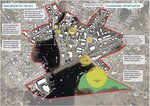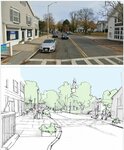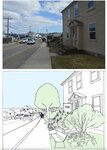



After several months of work between myriad Essex and Manchester town representatives and local businesses, the final Rapid Recovery Grant report was delivered with nine community projects designed to stimulate economic growth. It’s been an interesting project to watch, with engagement across different types of players. We sat down with Manchester Town Planner Sue Brown to learn about the six months of workshops and research that went into the final report, and to understand what happens next.
Cricket: The Rapid Recovery Grant is one of several regional grants secured by one or another towns and organizations on Cape Ann this year. This one was secured by Manchester and Essex from the state of Massachusetts.
Sue Brown: Yes, it’s called the Rapid Recovery Grant. Earlier this year, Matt Coogan, then the Town Planner in Essex, asked if Manchester would be interested in pursuing it because they didn't have the capacity to take on the grant alone. We knew applications were stronger if communities partnered up, so we did. And we got it. It was project started in April and continued through this month. It's part of a larger state effort to identify the business impact of COVID, collect data, and work with experts to identify local economic development opportunities that can be transformative.
Tell me about who participated. It seemed unique.
We had a Steering Committee with representatives from Manchester and Essex, working together. In Manchester, there were downtown businesses, like Amy Lage of Style Snoop, and local Board representatives, such as (Selectmen) Becky Jaques and (Planning Board member) Christina Deliseo. Town Administrative assistant Sonja Nathan was very active. We had members of the Downtown Improvement Committee, because they indicated a desire to serve as an ombudsman for the business community. We really wanted everyone to not only know what was going on but be able to provide input from their perspective.
And over in Essex, there was Ruth Pereen, Chair of the BOS, Town Administrator Brendhan Zubricki, and your counterpart, Town Planner Dana Menon. Donna Roy was there from the Essex Merchants Group, Jody Harris was from the Economic Development Committee. And then of course, Ken Reihl, CEO of the Greater Cape Ann Chamber, who is also an Essex resident.
Yes
This was a technical grant, so it was about accessing expertise rather than money. The Steering Committee’s main consultant was Dodson & Flinker that specializes in municipal planning work. But every week it seemed the team had a workshop with a different specialist firm with powerful experience. Is this normal?
It was really unique and special. For our regular workshops, Dodson & Flinker found subject matter experts in community wayfinding, public lighting and services, placemaking, economic development and other really helpful areas. Regardless of the strategy ideas the steering committee came up with, these firms had real-life experience and specific projects they could point to that we could learn from and emulate to meet our challenges. And they helped shape our own ideas. For instance, we came up with an idea to share an economic development expert between Essex and Manchester, to come in and help build our capacity within our communities and create a toolbox, if you will, for us and then phase out that person. That was a unique idea that is very much worth looking into.
Let’s talk about the set up. The firm dived into each community first, and assessed each town’s profile, customer base, physical environment, business environment and administrative capacity, correct? Then they explored compatibility and fit. And the opportunities of common interest. Is that right?
Yes, it was a very interesting process. I think people will really be surprised when they go through the report—and I hope they do—to see the depth of the inventory and the analysis they did on each town. They didn’t just ask the steering committee what it wanted and give back what we all wanted to hear. They were able to see two small coastal communities with a lot to offer, common challenges and interests in both the public and the private realms, and give thoughtful, researched answers that could provide impact. I was pleased with the depth of the report, and I think people will learn something from it.
Let’s talk about the final report. I believe there were nine final “shovel ready” programs, all potentially fundable by state grant money. What were some of the finalist programs that popped out at you?
Well, the programs were really interesting but one thing that really popped out at me was less about the projects—although I’ll get to them in a minute—and more about the insights. For instance, one of the interesting findings was that Manchester and Essex really shares a common customer base. There are differences in the towns, for sure, like walkability. But we really share customers. People go back and forth between the towns and we attract similar people. They would shop in either community. They would love to access the same type of services here. So, we started with the customer base and see the overlap, and that’s something really interesting, maybe something we hadn't concentrated or thought a lot about in the past.
That’s something the steering committee really latched onto. The Essex Merchants Group actively markets to visitors to come experience Essex … the food, the river cruises, the antiques. Manchester has the Commuter Rail and Singing Beach. And each town shares the Manchester Essex woods, and its trails. The report identified things that appeal to the customers we have in common, in areas like lighting, wayfinding and things like “placemaking.” Can you talk about that?
I believe “placemaking” ranked high in the report. In this context, placemaking is more about celebrating who we are, figuring out those shared values like the connection to outdoors, and culture and art, and then creating an environment that makes those things visible and easy to experience. So, it may be about a specific view down the Causeway in Essex, or about the harbor in Manchester, and how we can make those experiences better. Are there opportunities from the sidewalks, or the cut-through walkway between the Manchester’s public parking lot behind Town Hall to Beach Street’s downtown businesses. These are perfect opportunities. This connects to the final proposed project ideas in the report. One is about extending historic and public lighting. Another is addresses wayfinding and signage—both online tools and physical signage. There are ideas for marketing programs to address lower-traffic times of the year like January, February or March, when business is slow. And then of course, the idea of a shared ombudsman to focus on local economic development initiatives that are right for our communities and financially sustainable. It’s exciting.
You’re touching on why the deep dive into analyzing each community was valuable. The recommendations were all specific for us, and didn’t feel like they were for other towns or even cities. With wayfinding, for instance, the report understood that parking and lighting challenges in Essex were completely different than what is needed in Manchester. Same topic, different context.
Yes. I loved the ideas that came up in marketing. Both communities really acknowledged they need a longer operating season to be to be economically strong and viable. And the community members felt strongly that they wanted community events for locals that extend the calendar beyond the winter holidays. That helps create a sense of place, right? It creates vitality in the downtown and everybody wants that … ways to get out and meet up, and be with neighbors. And some great ideas came out of discussing events that could span both towns working together. I loved that.
And what about the idea of an ombudsman, of giving somebody the charge to actually be that linkage between town halls, businesses, and economic development?
Well, small communities have a have a hard time affording that type of expertise. If we can find a creative way to find someone to come in and get us started, give us the tools and set up the framework, it could be powerful.
What is the next step for this Rapid Recovery effort? What do we do now?
My understanding is the state is offering a little more help to further work on funding sources. So, now, each town and its stakeholders will look at the recommendations—the possible projects—and evaluate their merits. Then we can sharpen exactly where are the pots of money that can be used for each specific project. That can happen in the next month or so. It will be up to the Boards of Selectmen to get input from the various stakeholders and determine what are the strategies that we want to move forward with and how. Then we'll look for the funding sources and apply to those funding sources and move on from there.
As I reviewed the final report, it struck me that these final project ideas aren’t really about COVID at all, but just interesting ideas for our local economy, regardless.
Yes, that’s right. It was a great experience, and the report has a lot of value. I hope all residents of both towns take the time to read it. It’s got some very interesting insights and information about our downtowns, the future and how we can cooperate.